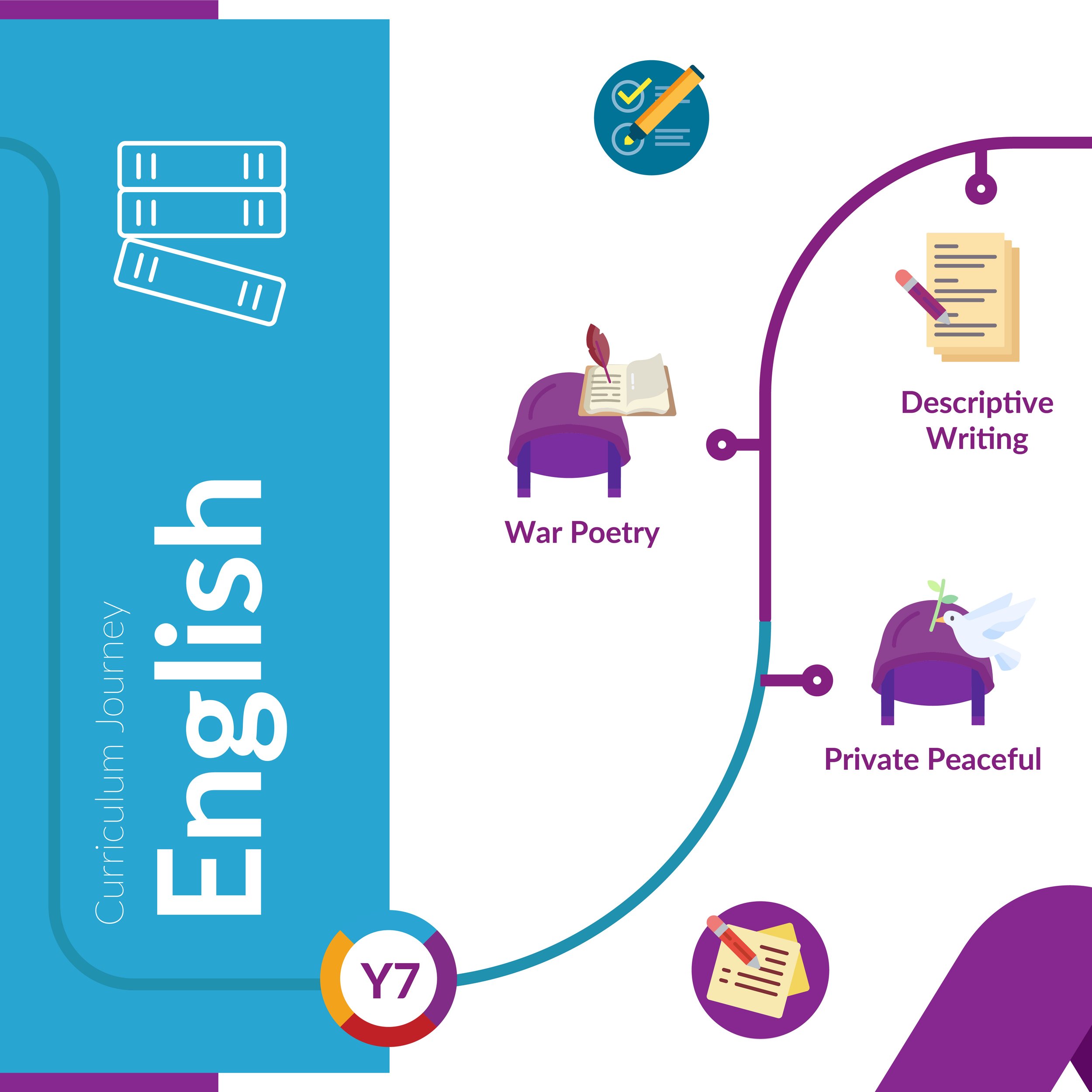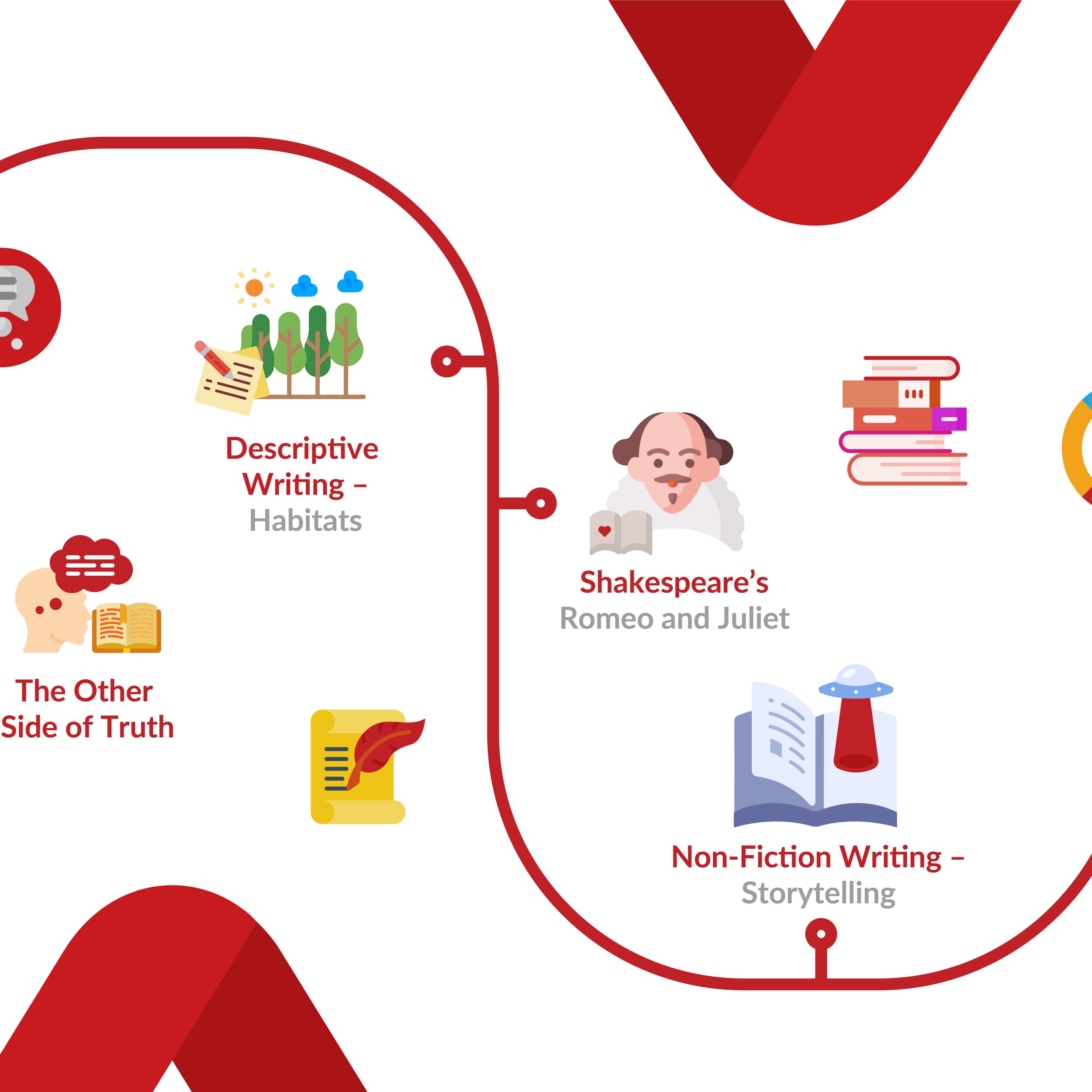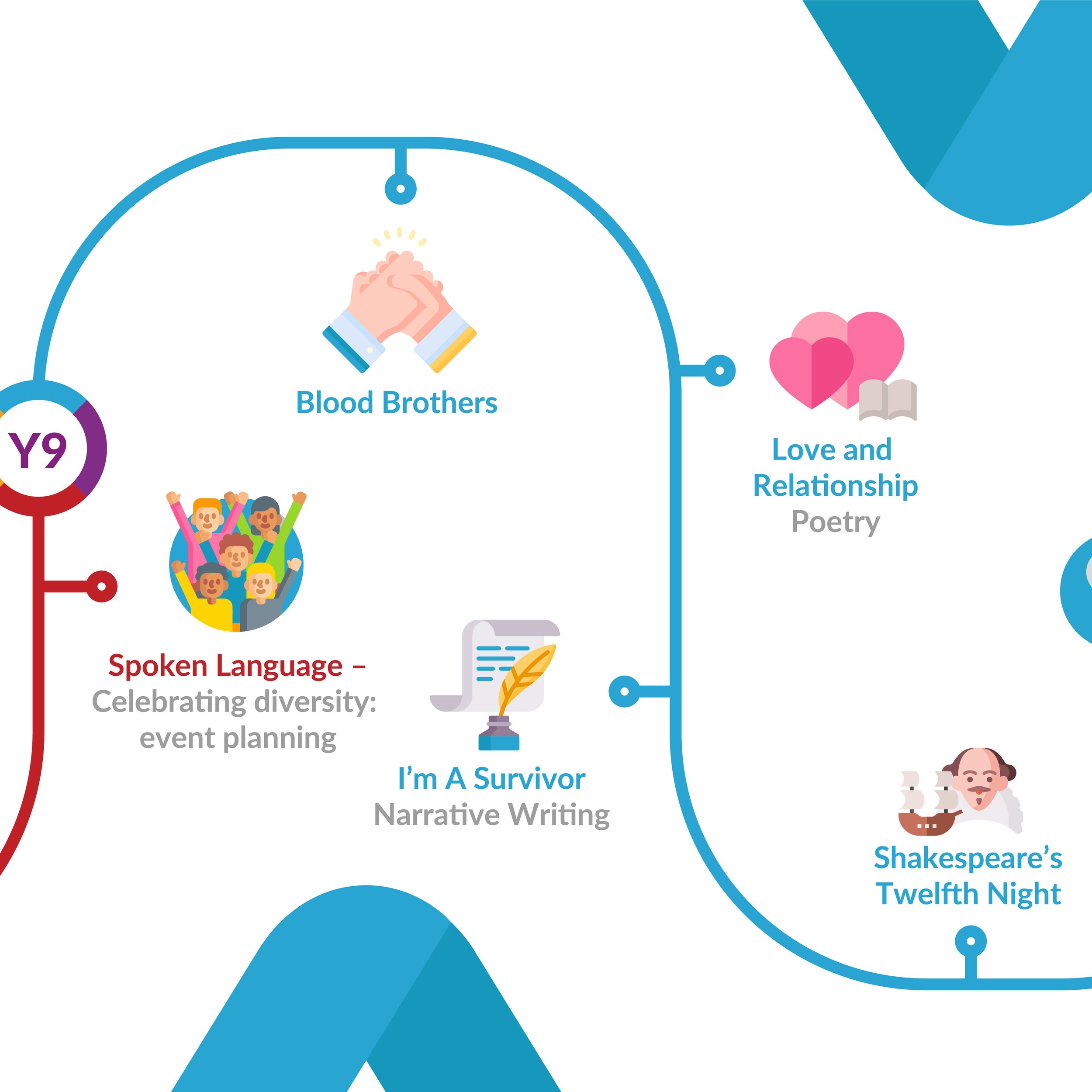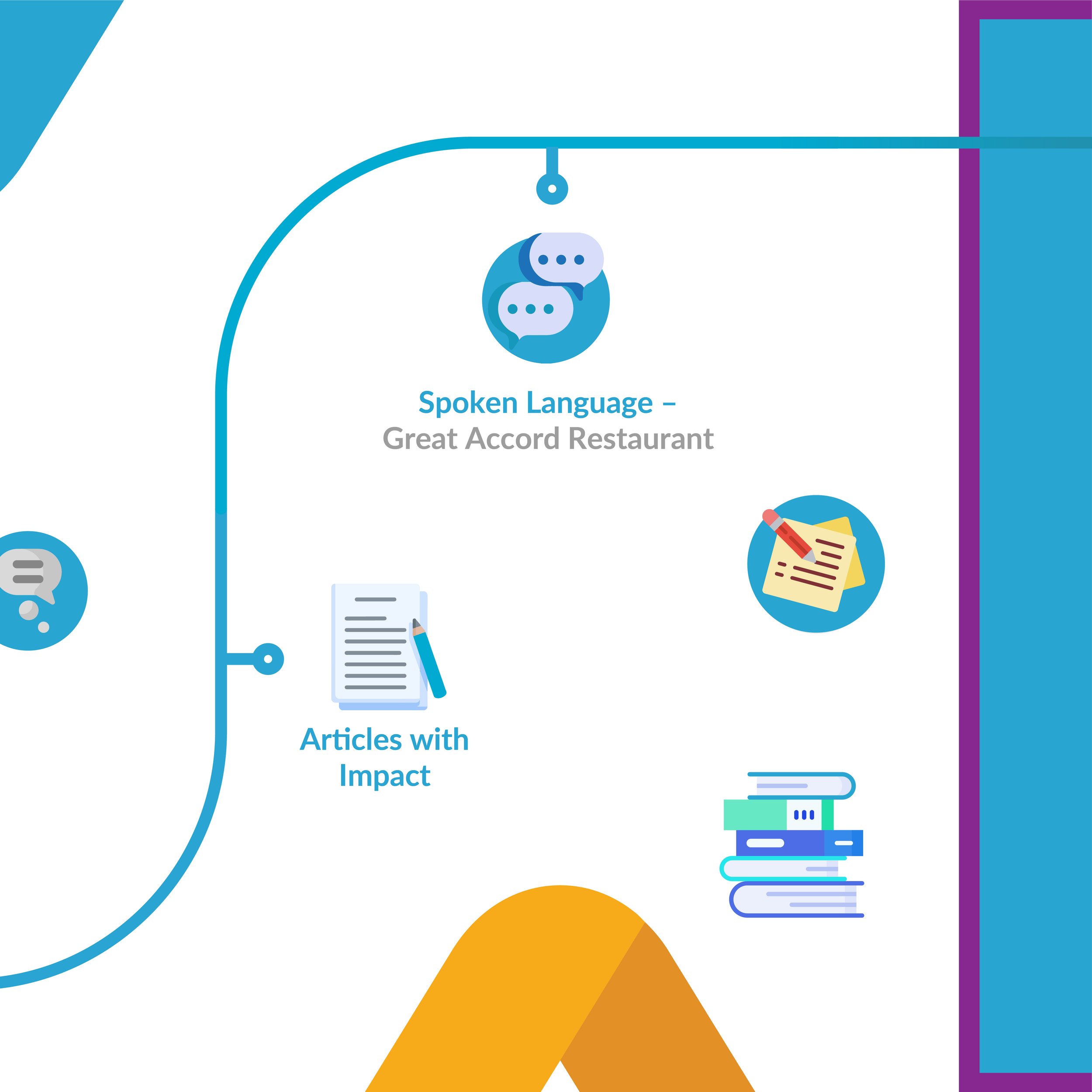
English
Year 7
Half Term 1
Whole Novel Study: Private Peaceful
-
This unit introduces ideas surrounding war, conflict and human relationships, through a close analysis of the novel.
Students will explore a range of extracts, characters and contextual links.
Key focus on family relationship between Tommy and Charlie.
The impact of war upon individuals and families.
Ideas surrounding loss.
The unit will allow students to study an extended text in-depth whilst also enabling them to understand the personal aspects, and effects, of war and conflict. Students will be able to understand wider structural features of fictional texts as well as close character analysis.
-
The ideas pupils will understand and the words they will be able to use.
Students will be introduced to a range of key vocabulary that links to themes such as: war, conflict, patriotism and propaganda.
Key vocabulary:
shellshock, comradery, grief, trench warfare, armistice, tolerance, foreshadowing, flashback, theme, metaphor.Extended vocabulary:
desertion, trauma, court martial, symbolism, time shifts, conscientious objection, jubilation, conscription.Reading skills:
inference, deduction and increased vocabulary understanding.Writing skills:
analysis of language, writing coherently, summarising, evaluating, arguing, discussing a point of view, emphasising key points, accurate use of Standard English (spelling, punctuation and grammar). -
Wider reading: War Horse by Michael Morpurgo, The Frightful First World War (Horrible Histories) by Terry Deary and Terrible Trenches Field Book (Horrible Histories Novelty) by Terry Deary, Horrible Histories: Frightful First World War.
Documentaries/films: Private Peaceful (2012), Our World War documentary (available on BBC iPlayer), Horrible Histories - Series 5: 15. Frightful First World War (available on BBC iPlayer), Series 5: 15. Frightful First World War.
Trips: The First World War Hospital at Lotherton.
There are range of resources on your child’s TEAMS class page. Here you will find lessons for the day, that are being completed in class, homework and additional resources. Please direct your child to check TEAMS regularly as this is updated regularly.
-
Half Term 2
War Poetry
-
This scheme of work builds on from student’s knowledge from Private Peaceful initially with a focus on WW1 poems. Well known poems such as Poppies, In Flanders Field and Dulce Et Decorum Est are. This also links into Armistice Day being at the time of this topic being studied.
The scheme then moves on to more recent poems about Sarajevo and then soldiers and their experiences in Iraq and Afghanistan more recently. Students gain an insight to what life was like for soldiers at that time and in that specific war.
-
The ideas pupils will understand and the words they will be able to use
Key terms:
Ambiguity, Alliteration, Personification, Metaphor, Simile Enjambment, Euphemism, Historical Context, Inference, Juxtaposition, Semantic Field, Structure, Symbolism, Themes.
Key vocabulary:
Grief, Patriotism, Sacrifice, Interpretation, Propaganda, Adversary, Contemporary, Pride, Bravery, Trauma, Shellshock, PTSD, Comradery, Civilians.
-
You could help support your child by researching other war poems and seeing how they compare to the ones we will study in class.
Help by checking students are understanding what they are being taught in History during the second half-term as they learn about WW1 at the same time as War Poetry.
You could also question your child about the poem/poet they are studying or have studied recently….
What is the poem about?
Did the poet experience war first hand?
What role did they have in the way?
Why do you think they wrote the poem?
What is the poet’s message?
How does the poem make you feel?
A trip to Edan Camp to find out more about war in the first half of the 20th Century in Britain?
There are range of resources on your child’s TEAMS class page. Here you will find lessons for the day, that are being completed in class, homework and additional resources. Please direct your child to check TEAMS regularly as this is updated regularly.
-
Here are a range of materials that may be useful for you and your child:
Cartoon of Dulce Et Decorum Est.
What it was like in a WW1 trench?
Interactive page where you can learn about trenches in WW1.
Facts and statistics about the Bosnian War.
Half Term 3
Gothic Reading and Writing
-
This unit introduces the Gothic genre by presenting students with a range of extracts from various writers.
By looking at how tension, suspense and atmosphere are created in the genre then replicating it in their own creative writing.
Students will learn narrative structures, descriptive writing techniques and characterisation. This unit presents students with the following texts:Castle of Otranto .
Beginning of The Woman in Black (TWIB) .
Harker’s journey to the castle (Dracula).
Jeykll & Hyde.
Frankenstein.
-
The ideas pupils will understand and the words they will be able to use.
Key techniques:
Pathetic fallacy, personification, metaphors, similes.Writing skills:
writing to describe, setting, location, atmosphere, Gothic, character, plot, accurate spelling, punctuation, grammar, crafting language for purpose.Key vocabulary:
eerie, obscure, tension, suspense, supernatural, labyrinth, peculiar, affliction, lamentable, melancholy, anguish, apprehensive, sorrow, dismal, ominous, gargantuan, mournful, bleak, omen . -
Family or individual reading of the texts listed above.
Consider how the weather is an important part of the setting in anything you are watching/reading together.
Discussion on how characters in literature and television are developed through movement and speech.
Places to visit:
Haworth; bleak and stormy landscape was the perfect location for a Gothic drama of obsession and violence.
The Bronte parsonage, The more adventurous can venture into the moors and seek out Top Withens, a ruined farmhouse reputed to be the inspiration for Emily Bronte’s Wuthering Heights.
Whitby; The windswept, atmospheric seaside town of Whitby was where Count Dracula first arrived in the UK. Bram Stoker’s Dracula is inspired some of the iconic scenes and characters in his famous novel
There are range of resources on your child’s TEAMS class page. Here you will find lessons for the day, that are being completed in class, homework and additional resources. Please direct your child to check TEAMS regularly as this is updated regularly.
-
Full texts: Affordable copies are available from book retailers.
Castle of Otranto.
Beginning of The Woman in Black (TWIB).
Harker’s journey to the castle (Dracula).
Jeykll & Hyde.
Frankenstein.
Links to Websites:
Helpful guide on writing to describe.
Simple gothic fiction overview.
Form, Structure and Symbolism in gothic fiction.
Video Links:
Half Term 4
Shakespeare: Shakespeare’s Villains
-
Study several villains from Shakespeare’s plays: Richard III, Lady Macbeth and Iago (from Othello).
Richard III is a play about evil, violence and murder. It charts the rise of Richard, Duke of Gloucester, a cold-blooded and dastardly villain who slaughters his family and even marries his victim’s widow to become king. It’s a history play, but the plot isn’t necessarily true to events: Shakespeare wrote the play during the reign of Queen Elizabeth I. The hero of the play, who ends Richard’s reign of tyranny, is Richmond, who goes on to become King Henry VII, Queen Elizabeth’s grandfather.
Three witches tell the Scottish general Macbeth that he will be King of Scotland. Encouraged by his wife, Macbeth kills the king, becomes the new king, and kills more people out of paranoia. Civil war erupts to overthrow Macbeth, resulting in more death.
Iago is furious about being overlooked for promotion and plots to take revenge against his General; Othello, the Moor of Venice. Iago manipulates Othello into believing his wife Desdemona is unfaithful, stirring Othello's jealousy. Othello allows jealousy to consume him, murders Desdemona, and then kills himself.
The focus for this scheme of work is character analysis and look at the key scenes where the villains carry out their evil acts.
-
The ideas pupils will understand and the words they will be able to use.
Words that are specific to plays: audience, aside, character, dramatic irony, playwright, stage directions, adaptation.
Words specific to language methods: metaphor, imagery, pun, simile.
Words related to key themes: monarchy, tragedy, plot, scheme, fate, dastardly, greed.
Others: connotations, implicit, explicit, inference.
-
Read the story of Richard III, Macbeth and Othello so they already understand the plot.
The Children’s book of Richard III by Rosalind Adam.
Richard III (Shakespeare Stories) by Andrew Matthews.
Watch animated versions of the play.
Take part in family discovery events.
There are live performances adapted for children, interactive workshops and family tours packed with behind-the-scenes secrets and costumes to try on you'll be spoilt for choice at the UK's leading Shakespearean theatres and venues.
The Royal Shakespeare Company in Stratford-upon-Avon offers family events, holiday activities, treasure trails, play carts and more.
Shakespeare's Globe Theatre in London brings Shakespeare to life for the whole family with live demonstrations, family events.
The Shakespeare Birthplace Trust runs family events and activities in all the historic houses it manages such as Shakespeare’s birthplace.
You could Immerse yourself in Tudor times and discover why William Shakespeare is one of the world's leading poets and playwrights. Lots of free Shakespeare games and activities are available online:Shakespeare for Kids from the Folger Shakespeare Library.
Games from Shakespeare's Globe's Playground site.
CBBC's Shakespeare page.
Playing for Shakespeare is a free desktop computer game for PCs and Macs from the Shakespeare Birthplace Trust
There are range of resources on your child’s TEAMS class page. Here you will find lessons for the day, that are being completed in class, homework and additional resources. Please direct your child to check TEAMS regularly as this is updated regularly.
-
Half Term 5
Communication
-
This unit introduces students to the power of persuasive writing. Students will gain the ability to craft language to convince a specified into a specific of thinking.
Students will be provided the opportunity to access examples of blogs, diaries and letters throughout history, to assist their understanding of multiple ways of communicating with, and persuading others, by writers such as:
Anne Frank
Gareth Southgate
Martin Luther King Jr
Mahatma Ghandi
Greta Thunberg
The scheme allows students to access a range of writers from various cultural backgrounds and eras, which will allow students to explore the changes in English language over time, while also being able to explore the vast cultural identities within English.
-
The ideas pupils will understand and the words they will be able to use.
Students will be introduced to a range of key reading and writing skills throughout this module to help embed subject knowledge in preparation for Key Stage 4.
Reading skills:
Inference, deduction, increased vocabulary understanding.Writing skills:
Crafting of language for purpose, application of structure to create cohesion.Throughout this module, students will also gain access to a wider vocabulary which will increase their understanding of the world and ideas which are presented within it.
Vocabulary:
Persuade, inference, letter, purpose, diary, blog, Analyse, Evaluate, democracy, empowered, change, diversity, manipulation, coercion, inclusion, civil rights, social hierarchy, race, gender, bias, emancipation, feminism, segregation, isolation, deprivation, climate change.Additional vocabulary:
Furthermore, in contrast, alternatively, counterargument, conclusively, anecdote.Students will also have the opportunity to develop their writing skills through the development of accurate use of Standard English (how we communicate), and accurate use of spelling punctuation and grammar.
-
You can assist your child throughout this module by having discussions at home based on culture and identity within the local area and Britain. It may also be useful to have discussions around expressing with different viewpoints.
Encourage your child to watch the news and read the daily newspaper then discuss the events after.
Questions you can ask you child to assist their understanding of communication:
How much do you agree with…? tell me why.
What is your opinion about…?
What counterargument could you create here?
Is this the only opinion that is correct, or can you think of another?
Who do you think your opinion would appeal to? Tell me why.
There are range of resources on your child’s TEAMS class page. Here you will find lessons for the day, that are being completed in class, homework and additional resources. Please direct your child to check TEAMS regularly as this is updated regularly.
-
A useful resource for persuasive writing.
Encourage your child to read the further reading around each of the writers they will study during this module.
Half Term 6
Oracy: The Art of Story Telling
-
During this scheme of work, pupils will develop their awareness and understanding of the origins and art of storytelling. Pupils will not only learn about how story telling links to culture and tradition but will also learn about the skills and techniques used to ensure the oral delivery and crafting of a story is engaging and exciting.
-
The ideas pupils will understand and the words they will be able to use.
Oracy, storytelling, anecdote, culture, tradition, ancestry, body language, manner of articulation, tone, volume, facial expression, theatrical property.
Pupils will understand:
The impact of body language, expression, and performance?
The origins of story telling.
The differences between the written and oral word.
-
You can support your child by discussing different types of stories. Ask them about their favourite stories and ask them to explain why they like their chosen one. You can also encourage your child to speak fluently and in full sentences to fully articulate their ideas.
Support your child by asking them to practice presenting their story to you, ask them questions about the story and elements of their performance and discuss where it could be developed. You can then encourage them to make eye-contact, speak clearly and fluently and have positive body language. Praise them for acting on praise.
You can also explore a range of story telling’s through BBC 500 words competition, this website contains lots of different performances where celebrities read out stories written by children of the same age as your child.
Keep up to date with what your child has been learning through the class Teams channel and SharePoint where lessons and materials will be posted.
-
HOW CAN YOU HELP TEACH YOUR KIDS, THE ART OF STORYTELLING?
1. READ TOGETHER
Good readers make good storytellers. Reading to your baby right when it is in the womb is scientifically proven to have your baby build vocabulary, stimulates imagination, and improves communication skills. If you missed that part, then don’t worry. Read to them now before it’s too late. Inculcating them into the world of books is quite essential for them to become an effective storyteller. Read along with them, narrate by using your expressions well to help them know the vibe of the book, make them repeat lines and interact to keep them excited. Share your personal experiences. As a child, haven’t you enjoyed your grandma’s stories? Think of those stories and share them with your child. Have them narrate it to you or your family. Over time, they would pick up this skill and begin to share their own life experiences. Become a fun storyteller yourself as you know how great copycats our kids are!
2. TAKE THEM TO STORYTELLING EVENTS OR CLASSES
There are plenty of storytelling events or classes organized locally either by libraries or other associations. Make them be a part of it. Let your toddler absorb a real and professional storytelling experience. Once they cherish this newly found interest, you can enrol your tot into a storytelling class. This way kids establish and nurture their skills further.
3. PLAY STORYTELLING GAMES
Kids love the idea of gamifying. Using a hint of games in the storytelling process will seize their attention without ruining the fun part. One such amusing activity is String-a-long storytelling. Play in groups or just two of you. This game involves one of you to start the story, passing the story along to the next participant until it reaches a climax. Thereby, letting kids can use their imagination and creativity to build a story. Another way to gamify storytelling is to show them a picture, an object, or any other props. Now ask them to create a story scene around the thing. You may not notice an instant interest but with time and constant practice, you are sure to witness your child instigate the art of storytelling in themselves.
4. ALLOW THEM TO CHOOSE
We know how kids love to pick their own toys and clothes. Likewise, allowing them to choose their stories that they wish to narrate. It is important to respect your child’s choices. You can also guide them by making them choose the right stories that are not too wordy, include a repetitive refrain, has a lot of scope for expressions and asks for audience engagement. This way they will be more interested in learning this new skill.
5. PRACTICE IS THE KEY
Now that your child is intrigued by the power of storytelling, encourage him by establishing storytelling in their daily routine for enough practice. Be it in front of a mirror or a bunch of few other kids, let your child showcase his/her talent. Storytelling for toddlers is known to develop confidence and self-esteem, helping them in becoming better communicators.
Assert no pressure on your child as developing a new skill takes a lot of time and practice. But do not forget to have all the fun and frolic while exploring the realms of the story-telling process.
WEBSITES
On YouTube, you could visit the TEDtalks channel which has an array of anecdotal storytelling’s which might inspire your child to create a non-fiction story for sharing.





